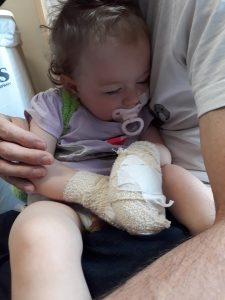Investigations
BARIUM SWALLOW
The baby/child is given a white strawberry flavoured liquid to swallow. For babies this will be administered from a bottle, or through a nasal gastric tube if necessary. An X-ray is taken by a Radiologist (X-ray Doctor), which is projected on a video screen, and then analysed.
This investigation is positive in approximately 50 to 60 percent of babies/children who clinically suggest GOR (gastro-oesophageal Reflux). The examination may demonstrate reflux, the wave pattern in the oesophagus, and the rate of emptying of the stomach. Importantly, this investigation shows whether the anatomy of the oesophagus and stomach are normal and if the baby/child has a hiatus hernia.
Babies/children with GOR may not reflux during the period of the screening, producing a normal reading. A Barium Swallow is therefore not a very reliable test for reflux, as it is possible for a baby/child to have reflux but it not to be picked up by this investigation.
It is common for the Barium preparation to cause constipation, and it should not be left to harden in the bowel. Therefore a laxative may need to be used if constipation is, or becomes a problem. It is useful to take the baby/child’s favourite bottle or cup to administer the barium preparation, as this may make the procedure more acceptable to them.
GASTROSCOPY/ENDOSCOPY
This investigation involves 15 minutes under a general anaesthetic if the symptoms and signs suggest reflux oesophagitis. The endoscopist (the doctor who performs the endoscopy) is able to assess the degree of oesophagitis (inflammation in the oesophagus), and whether there are any problems in the stomach and duodenum. A biopsy (specimen of the oesophageal lining) may be taken for pathological examination.
Other conditions such as coeliac disease (gluten intolerance), food allergies, lactose and other sugar intolerances, helicobactor pylori etc. can also be diagnosed from appropriate biopsies taken during an endoscopy.
This investigation is also a very important step before surgery is considered.
pH PROBE
A probe sensitive to pH changes (thus an index of acidity) is positioned in the oesophagus. This investigation demonstrates the presence, frequency and duration of reflux episodes. For accuracy of result, the probe is left in the oesophagus for 18 – 24 hours, and an X-ray needs to be taken once the probe is in place to confirm it is positioned accurately.
This is a good test for determining whether a baby/child has reflux or not, and the severity of the condition. Several types of readings are taken, but the most crucial one is the % of reflux over 24 hours. In general: – under 5% is normal, 5 – 10% is mild, 10 – 20% is moderate and over 20% is severe. However, the severity of the condition is no indication of treatment needed e.g. a baby/child with mild reflux may still need Omeprazole, whereas a baby/child with severe reflux may remain well controlled on Zantac.
OTHER
Diagnosing GER in Children – http://www.medscape.com/viewarticle/742615?src=mp&spon=9 – “The measurement of pH is the predominant modality used to diagnose gastroesophageal reflux (GER) in children. However, pH monitoring provides only part of the answer with respect to whether a child has reflux episodes. Multichannel intraluminal impedance monitoring can measure acidic and nonacidic reflux episodes using pressure-sensing electrodes along the length of the probe.” I haven’t heard of impedance monitoring being used in New Zealand.

© Gastric Reflux Association for the Support of Parents/babies (GRASP) and Crying Over Spilt Milk Gastric Reflux Support Network New Zealand for Parents of Infants and Children Charitable Trust (GRSNNZ) 2004. Used, edited and added to by GRSNNZ with permission.
Page may be printed or reproduced for personal use of families, as long as copyright and Crying Over Spilt Milk‘s URL are included. It may not be copied to other websites or publications without permission and acknowledgement. This information (unedited) was also provided (by GRASP) to health professionals in New Zealand to use ” to continue to support and inform families with babies/children with Gastro-oesophageal Reflux.”
